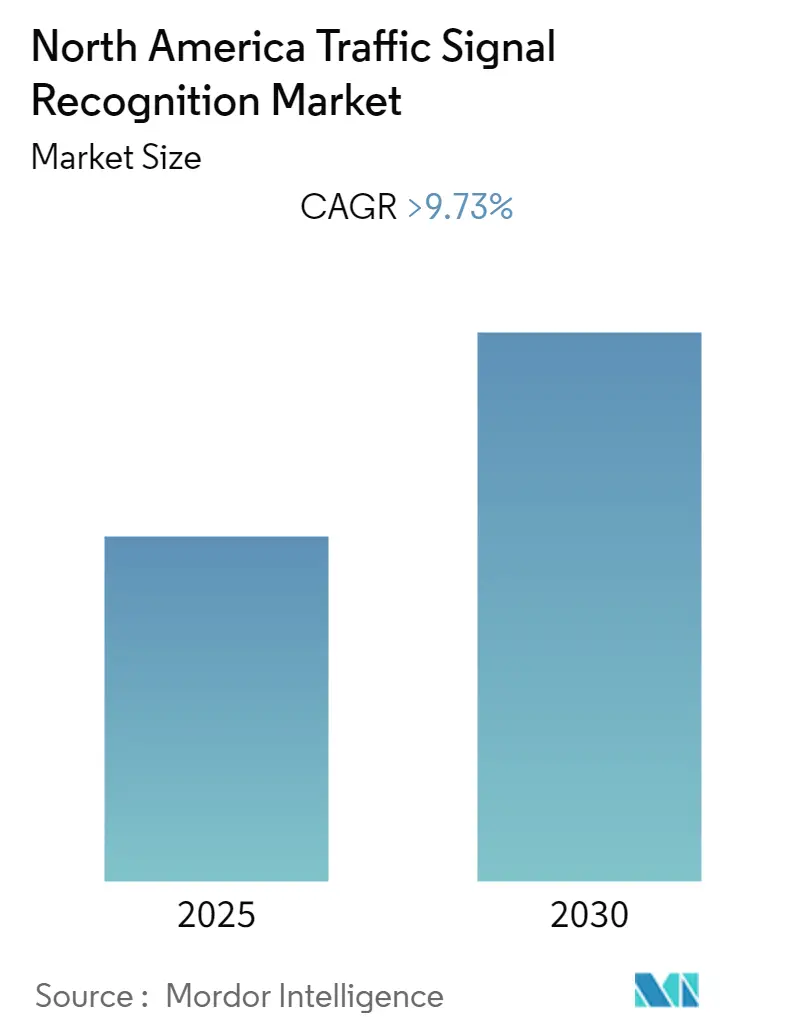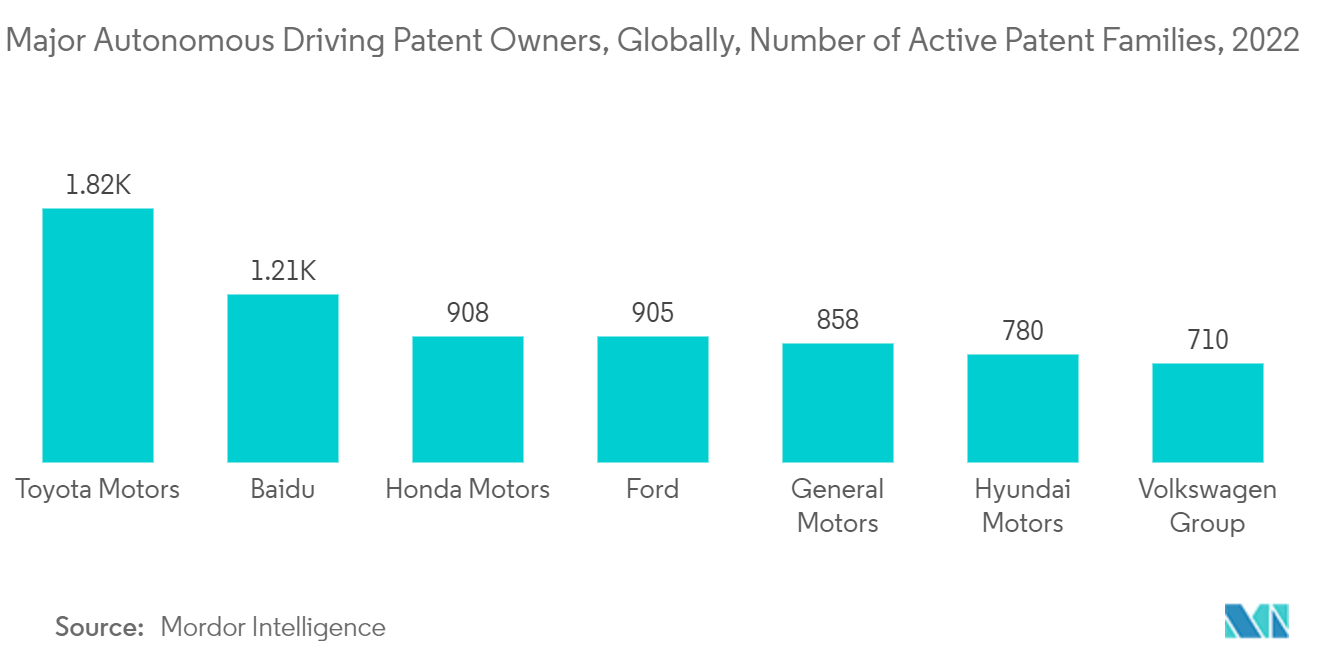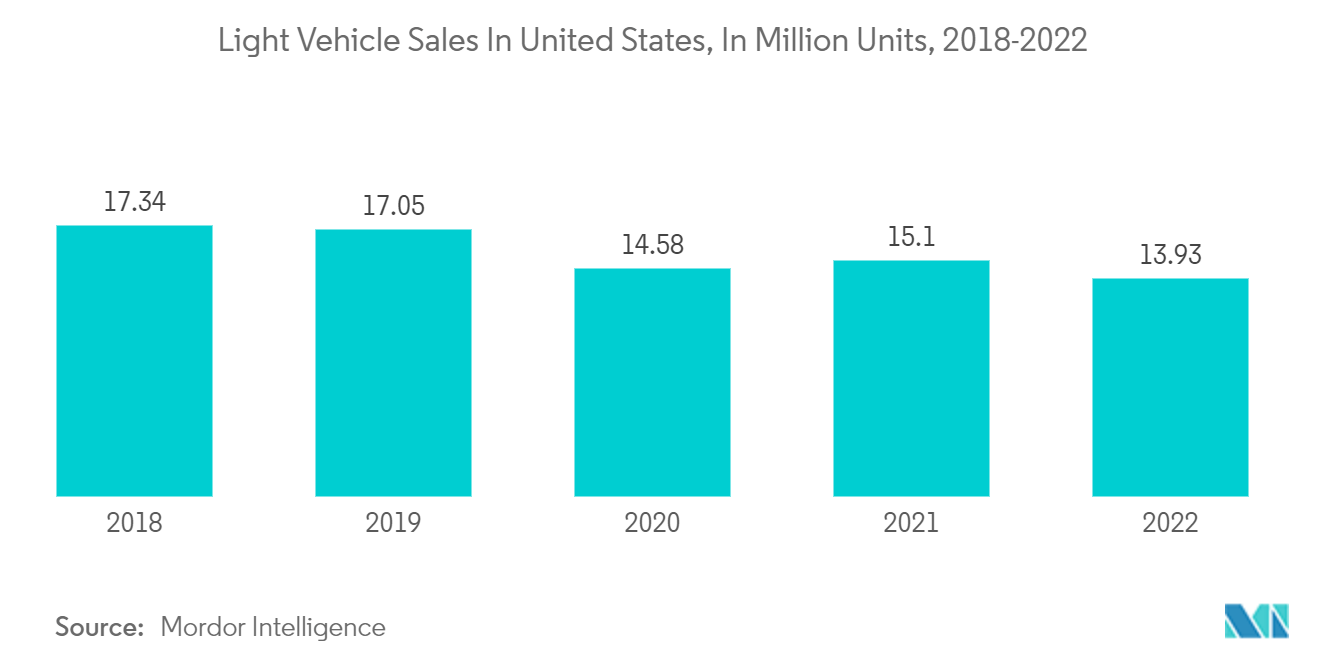North America Traffic Signal Recognition Market Analysis
The North America Traffic Signal Recognition Market is expected to register a CAGR of greater than 9.73% during the forecast period.
- Traffic signal recognition is a driver support function used to notify and warn the driver about the restrictions that are effective on the road. Such restrictions include 'speed limit zones' or 'no-overtaking' indications. The system can help the driver to maintain a permissible speed and obey the local traffic instructions or any other urban restrictions.
- Stringent emission regulations, adoption of enhanced technologies for road safety, advancements in research into sensors, cameras, and other automobile technologies, and scaling of manufacturing of sensor-based technologies across the world are some of the drivers for traffic signal recognition-enabled vehicles.
- As fatalities are increasing across the region, organizations involved in car safety regulations are focusing on advanced driver-assistance systems (ADAS) to enhance the safety of both passengers and pedestrians.
North America Traffic Signal Recognition Market Trends
Rise in Stringent Government Regulations and Growing Demand for Autonomous Vehicles
- The autonomous vehicles market in the United States is estimated at 3.4 thousand units in the year 2021. The country currently accounts for a 40% share of the global market.
- The number of on-road accidents is increasing rapidly, and it is estimated that, on average, every single road accident results in at least two deaths and five serious casualties. According to the World Health Organization (WHO), nearly 1.25 million deaths occur due to road accidents annually. The efforts of various governments to reduce fatalities from road accidents have led to increased safety standards in new vehicles.
- Organizations involved in car safety regulations are focusing on ADAS for enhanced safety of both passengers and pedestrians. The American New Car Assessment Program (NCAP) and the European New Car Assessment Program (Euro NCAP) have made certain features of the advanced driver-assistance system (ADAS) mandatory in new vehicles.
- Currently, Audi, Ford, BMW, Mercedes, Volvo, and Honda are some of the major companies deploying the traffic sign recognition system in their vehicles. With the ongoing technological advancements in the traffic sign recognition system, the demand for components like processors and image-sensing cameras are likely to increase and is expected to drive the market.
- The growing demand for autonomous vehicles is driving traffic signal recognition, as the development of semi-autonomous vehicles is expected to continue till the end of this decade. With the expansion of urban autopilot systems, the vehicles are expected to go fully autonomous by the end of 2025. These features can reduce the fatalities due to road accidents by up to 80%.
Passenger Car will hold the major share in the Market.
- North America is a significant market for passenger car sales, encompassing countries like the United States, Canada, and Mexico. Historically, these countries have seen strong demand for passenger cars, with various factors influencing sales figures.
- United States' new vehicle sales of 1,374,910 units for May represented an increase of 1.3% from April 2023 and an increase of 22.8% from one year ago in May 2022 when supply chains restricted production, with all major manufacturers showing gains.
- There were 25 selling days in May 2023, one more than the 24 selling days in May 2022. May's passenger car sales increased 17.8% to 299,842 units, resulting in a 21.8% market share, while sports utility vehicle (SUV) and truck sales increased 24.3% to 1,075,068 units, resulting in a 78.2% market share.
- Passenger cars are a significant segment of the automotive market in North America. The integration of TSR systems in passenger cars has the potential to enhance safety by providing drivers with real-time information about traffic signals, helping them make informed decisions, and reducing the risk of accidents caused by human error or distraction.
- However, it is important to note that the adoption of traffic-sign recognition systems in passenger cars may depend on various factors such as vehicle models, trim levels, and optional features. Additionally, government regulations and safety standards can influence the incorporation of traffic-sign recognition technology in passenger cars.
- Considering the increasing advanced driver-assistance system (ADAS) features in passenger cars, and the increasing sales of passenger cars in North America will drive the market in the coming future.
North America Traffic Signal Recognition Industry Overview
The North Americatraffic signal recognition market is consolidated with many major players like Robert Bosch Gmbh, DENSO Corporation, Continental AG, Toshiba Corporation, HELLA GmbH & Co. KGaA, and others.
The market is transforming at a rapid pace, and in the coming year, many new ADAS technologies will come, although traffic signal recognition technology will have the highest priority in ADAS. Additionally, companies are introducing various new technologies and joining hands with other players to stay ahead in the market.
For instance, in April 2022, Bosch acquired Five AI, a company specializing in developing autonomous vehicle (AV) software.
North America Traffic Signal Recognition Market Leaders
-
Robert Bosch Gmbh
-
Continental AG
-
Toshiba Corporation
-
HELLA GmbH & Co. KGaA
-
DENSO Corporation
- *Disclaimer: Major Players sorted in no particular order
North America Traffic Signal Recognition Market News
- January 2023: Continental and Ambarella, Inc. announced a strategic partnership to jointly develop scalable, end-to-end hardware and software solutions based on artificial intelligence (AI) for assisted and automated driving (AD).
- May 2022: NI and key partners announced the deployment of a fleet of vehicles in Europe, the United States, and China that will enable advanced driver-assistance system (ADAS)/autonomous driving engineering teams to address top challenges related to data volume, quality, access, and utilization.
North America Traffic Signal Recognition Industry Segmentation
Traffic-sign recognition (TSR) is a technology by which a vehicle can recognize the traffic signs put on the road, for example, "speed limit," "children," or "turn ahead." This is part of the features collectively called advanced driver-assistance systems (ADAS). A variety of automotive suppliers is developing the technology. It uses image processing techniques to detect traffic signs. The detection methods can be divided into color-based, shape-based, and learning-based.
The North American traffic signal recognition market has been segmented by traffic sign detection type, vehicle type, and geography. By traffic sign detection type, the market is segmented into color-based detection, shape-based detection, and feature-based detection. By vehicle type, the market is segmented into passenger cars and commercial vehicles. By geography, the market is segmented into the United States, Canada, and the rest of North America.
The report offers market size and forecast in value (USD) for all the above segments.
| Type | Color-based Detection |
| Shape-based Detection | |
| Feature-based Detection | |
| Vehicle Type | Passenger Cars |
| Commercial Vehicles | |
| Geography | United States |
| Canada | |
| Rest of North America |
North America Traffic Signal Recognition Market Research FAQs
What is the current North America Traffic Signal Recognition Market size?
The North America Traffic Signal Recognition Market is projected to register a CAGR of greater than 9.73% during the forecast period (2025-2030)
Who are the key players in North America Traffic Signal Recognition Market?
Robert Bosch Gmbh, Continental AG, Toshiba Corporation, HELLA GmbH & Co. KGaA and DENSO Corporation are the major companies operating in the North America Traffic Signal Recognition Market.
What years does this North America Traffic Signal Recognition Market cover?
The report covers the North America Traffic Signal Recognition Market historical market size for years: 2019, 2020, 2021, 2022, 2023 and 2024. The report also forecasts the North America Traffic Signal Recognition Market size for years: 2025, 2026, 2027, 2028, 2029 and 2030.
Our Best Selling Reports
North America Traffic Signal Recognition Industry Report
Statistics for the 2025 North America Traffic Signal Recognition market share, size and revenue growth rate, created by Mordor Intelligence™ Industry Reports. North America Traffic Signal Recognition analysis includes a market forecast outlook for 2025 to 2030 and historical overview. Get a sample of this industry analysis as a free report PDF download.





.webp)

